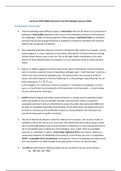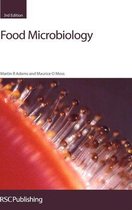Summary FHM-35806 Advanced Food Microbiology (January 2020)
Microbiological Food Safety
Food microbiology spans different aspects: food safety relies on the absence (or presence) of
pathogens; food quality depends on the success of fermentation processes or the presence
of unappealing, visible colonizing organisms (food spoilage); functional foods are prebiotics
(promote the growth of target bacteria) or probiotics (contain live microbes) that intend to
enhance the human gut microbiome.
Data regarding food borne diseases should be interpreted with caution: for example, Listeria
monocytogenes is a focus organism in food safety, although the %Listeria infections among
all food-borne disease cases is very low. Due to the high fatality contribution to the total
amount of food-related deaths, this organism is a very important factor in enhancing food
safety.
Hald et. al. (2004) suggested a formula that can be used to estimate the number of disease
cases in humans caused by means of ingesting a pathogen type ‘i’ with food type ‘j’ used as a
vehicle that may contain the pathogen type. The formula takes into account a variety of
factors that either depend on the food (subscript j), on the pathogen type (subscript i) or on
both (subscript ij): λ ij=M j Pij qi a j
In this equation, M = total mass of food j consumed, P = prevalence of pathogen i in food
type j, q = food factor (survival/growth of the bacterium in the food type), a = total number
of cases estimated for food type j.
HACCP (Hazard Analysis and Critical Control Points) is a concept used to maintain product
safety and quality as much as possible. Hazards, CCPs and limits (what is considered
acceptable and what’s not) are determined by means of quality risk assessment (QRA) and
are parts of managing responsible food handling. On the other hand, the paperwork has to
be done as a demand of ISO/certification instances. Documentation and verification are
essential to keep track of quality and safety.
The risk of food-borne diseases cannot be reduced to 0. However, one can do as much as
possible to reduce the risk as far as one could. This implies that there will be always a (tiny)
risk of accidentally falling ill due to food infection or poisoning. It is up to the government to
set an acceptable norm of intake of a food pathogen. Such ‘cutoff’ value of acceptable
exposure to a pathogen is called a Food Safety Objective (FSO). Such value is picked as a
compromise between the likelihood of becoming ill, so the #cases per year in a population
(ALOP = acceptable level of protection) and exposure. Hence, the pathogen prevalence level
that corresponds to an ALOP thought to be appropriate is chosen as the FSO-value.
The FSO demands that the following holds true for a product to be put on the market:
Ho – ΣR + ΣG + ΣC < FSO
, In words, this means that the initial level of the pathogen present in the food product minus
all reduction steps (e.g. heating of the product) plus all growth steps (e.g. during different
moments of storage) plus all (re-)contaminations of the product should be less than the FSO.
The FSO norm is set for the prevalence upon consumption by the consumer. For each
individual step in the food chain, a prevalence level is set to a value that resembles the FSO
(the same summation of microbial losses and additions hold true), but now it’s called a
performance objective (PO). The components of the summation are set to desirable levels
(reduced recontaminations, enhanced microbial inactivations) which are known as
performance criteria (PC).
Risk Assessment
A hazard is a biological, physical or chemical agent that may cause an adverse health effect. A
risk is a function of severity (impact) and probability regarding a hazard.
Procedure of risk assessment: Hazard identification (what agent is present that may cause
harm?) → Hazard characterization (dose-response: what is the severity of adverse health
effects after being exposed to the observed hazard level?) → Exposure assessment
(estimating or measuring the magnitude, frequency and duration of exposure) → Risk
characterization (define the nature and degree of the risk under specific exposure conditions
to the hazard; determining P(adverse effect) under given exposure).
Risk assessment is done by scientists and is the initial driving force of the machinery that
involves risk management (governmental, corporate and international trade task) and risk
communication between stakeholders. A model for risk assessment is built based on both
data (on prevalence, processing, epidemiology, etc) and assumptions that should be made.
Knowledge on the risk assessment procedure will be expected on the exam => practice steps
and read example assessment paper on Brightspace.
Whole-Genome Sequencing
For those reading this summary that lack or want to refresh knowledge on basics of DNA
structure and replication: I highly recommend having a look at this CrashCourse video
(duration: 13 min).
Genome sequencing can be used as a means to identify microbes, to enhance producer
(fermentation) organisms in food industry, finding sources of disease outbreaks or to
specifically identify targets for pathogenic strains. Below, I have added a description of the
classical Sanger sequencing method which still is the base for next-gen sequencing methods:
4 parallel reaction are run simultaneously, each reaction contains the amplified target DNA, a
primer, each dNTP type and a single ddNTP type (in a much lower concentration). By cycles of
, amplification, complementary DNA-fragments are generated until a ddNTP is incorporated.
Many fragments of different lengths are obtained for each single reaction, with a ddNTP at
every possible position. Finally, each of the fragment mixtures is separated on a gel; from
below (smallest fragments) to above, the DNA sequence can be read in 5’ -> 3’ order.
https://www.youtube.com/watch?v=3M0PyxFPwkQ
Note that nowadays, all four ddNTPs are added to one single reaction since a fluorescent
label (unique color for each ddNTP) allows for automatic sequence determination by a
fluorescence detector after the fragments have been separated based on size in a capillary
gel.
Shotgun sequencing is a technique in which the DNA of interest is fragmented, subsequently
all fragments are sequenced. Assembly software can either do a de novo assembly, or map
the reads to a pre-existing reference genome (for more details: see bioinformatics-related
courses).
Next gen-seq allows for high DNA throughput: many shotgun fragments can be sequenced
simultaneously, thereby reducing time and cost per sample/species analysis. Nanopore
sequencing is one of the latest sequencing innovations and is remarkable as it produces one
long DNA read (read length = inserted DNA molecule length) and therefore no assembly step
is required. A video on Illumina sequencing can be found here. Basically, adapters are added
to DNA fragments which make them bind to adapter-complementary sequences on an
Illumina chip. To each chip-bound DNA fragment, a complementary sequence is synthesized.
Upon incorporation of a nucleotide, a light flash is emitted; the color is unique for each
nucleotide, hence the sequence for a fragment on a certain spot on the chip can be
determined by recording the sequence of light colors emitted from that spot.
An interesting application of WGS in food safety, is the construction of food pathogen
databases. If many variant strains of pathogen X are included in the database, in which
additional information (occurrence, special genetic abilities, degree of pathogenesis, etc) has
been included to each inserted sequence, this information can be retrieved during a new X
outbreak when a hit to the database is found while taking the sequence of the current
outbreak strain as a query. Hence, more outbreaks can be solved, and due to quick
intervention (early food source identification), fewer cases per outbreak can be achieved.
Enrichment Ecology
Ecology studies the interactions of organisms with their environment and with each other.
The study of biotic abiotic aspects allows for better understanding of the behavior of a
contaminating microorganism on a (food) product.
Campylobacter species are gram negative, thermophilic rod-shaped bacteria that are
currently one of the leading causes of food infections worldwide given its high DALY value.
Paradoxically, this genus is sensitive to a variety of stresses such as drying, freezing and
oxygen (as they are microaerophilic). The dose-response for Campylobacter spp is low.






